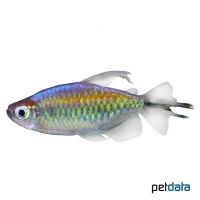Congo Tetra (Phenacogrammus interruptus)
| Congo Tetra Phenacogrammus interruptus | |
|---|---|
| Name | Congo Tetra |
| Name Lat. | Phenacogrammus interruptus |
| Family | African Tetras |
| Family lat. | Alestidae |
| Order | Characins |
| Order lat. | Characiformes |
| Origin | Congo |
| Habitat | Tributaries, lakes |
| Diet | Carnivore |
| pH | 6.0-7.0 |
| Behavior | Peaceful |
| Keeping | Group |
| Care Level | Moderate |
| Reproduction | Egg scatterer |
| Breeding | Moderately difficult |
| Life Span | 8-10 years |
| Protection | No |
| Metric Units | |
| Size | 6-9 cm |
| Temperature | 22-25 °C |
| Hardness | 3-10 °dH |
| Aquarium | ~ 250 l |
| US Units | |
| Size | 2.4"-3.5" |
| Temperature | 72-77 °F |
| Hardness | 53-178 ppm |
| Aquarium | ~ 65 gal |
Distribution and habitat
The distribution area of the Congo tetra is the middle inlet of the Congo (Democratic Republic of the Congo). They live in lakes and slow-flowing rivers with muddy bottoms and partly dense underwater vegetation.
Maintenance
The aquarium should have a varied planting, which offers both shelters, as well as plenty of free swimming space. With some shaded light (floating plants), a dark substrate and slightly acidic water they show the most beautiful coloration.
No ammonia, ammonium and nitrite should be detectable, the nitrate value should not exceed 100 mg/l. To ensure the water quality and oxygen content, a filter and heater adapted to the aquarium size is required, as well as lighting for the species-appropriate day-night rhythm of the animals.
Diet
They feed mainly on insects and insect larvae. The food supply consists of dry, live and frozen food. For a balanced diet, feed once a day with a high-quality, protein-rich dry food (flakes, granules, pellets) supplemented with cyclops, daphnia, artemia, mysis, tubifex, mosquito larvae, etc. (live or frozen)
It is recommended to feed small portions several times a day. Only feed as much as will be eaten within a few minutes. A regular and varied diet promotes health and increases resistance.
Behaviour and compatibility
They are peaceful, swimming schooling fish for any community tank and can be socialized well with other peaceful fish, except for species known as fin snappers. A group of at least 5, but preferably more Congo Tetras must be kept together. They tend to remain shy in groups that are too small.
Basically, only mutually compatible fish species with similar requirements for water conditions and water temperature may be socialized.
Sex dimorphism
The dorsal fin of males is elongated and the middle rays of the caudal fin are elongated like a cusp, females are smaller and paler in color.
Reproduction and breeding
They spawn in the open water at the bottom. The larvae hatch after about 35 hours and swim freely after about 6 days. The parents do not perform brood care and should be separated from the fry after spawning, as they are spawn predators.
Juveniles must be fed several times a day with special rearing food (Artemia). Breeding is hardly possible in a community tank, as the spawn is easy prey here.
Important
In their wide range there are some differently colored populations
The addition of peat extract or filtering through peat promotes the well-being and increases the color intensity of the animals.
The well-being of the fish should be monitored regularly. Temperature should be checked daily, pH, hardness and nitrate levels should be checked at least every 14 days. Regular partial water changes are recommended, even if the contaminant level has not yet reached the upper limit. Sudden changes in water quality should be avoided. Newly introduced fish must be accustomed slowly to the water in the aquarium.
Further literature can be found in your pet store.
References
Text: petdata; Image: petdata
Source: BMELV (1998): Tierschutzgutachten - Haltung von Zierfischen (Süßwasser); RIEHL & BAENSCH (2006): Aquarien Atlas Bd. 1, Mergus Verlag; ENGELMANN (2005): Zootierhaltung - Tiere in menschlicher Obhut: Fische, Verlag Harri Deutsch
- Gemäß § 21 Abs. 5 Tierschutzgesetz idgF
